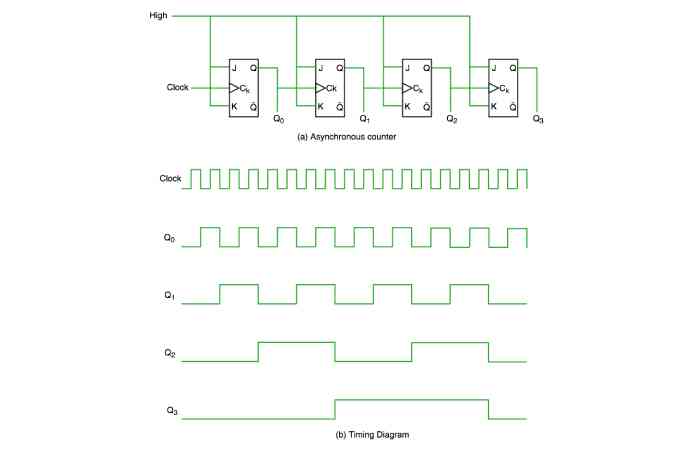Asynchronous vs. Synchronous Counters
A synchronous counter is one in which all flip-flops are timed simultaneously with a similar clock input. On the contrary, an asynchronous counter is a device in which all the flip-flops that make up that counter are clocked with different input signals at different instants of time.
A counter is a digital, mechanical, or electromechanical device designed for precise, automated counting and tallying. These instruments are a common sight across various industrial, project, and commercial applications, such as in analogue to digital converters and digital clocks. You can buy them at any reputable seller e.g. RS Components.

Asynchronous and synchronous counters are the most common counter types today but have distinct differences. In this article, we’ll dive into the specifics of each kind and finish by highlighting their respective advantages and disadvantages.
Table of Contents
What is an Asynchronous counter?
An asynchronous counter, a ripple counter, or a propagation counter doesn’t require a clock to count. Rather, it counts the number of pulses it receives from an external source, displaying the results on its screen.
Because an asynchronous counter’s output is free from a simultaneous clock signal, its output may be delayed. Only the first flip-flop will be externally clocked with a clock pulse, while any further flip-flops are the output of a previous flip-flop.
Some common applications of asynchronous counters include:
- Frequency dividers
- Low-power or low-noise emission applications
- Asynchronous decade counters
What is a Synchronous counter?
Synchronous counters feature a series of interconnected flip-flops. Unlike asynchronous counters, the flip-flops in a synchronous counter all change state simultaneously (normally on the clock pulse).
Synchronous counters are also often known as parallel counters. This name stems from the fact the clock feeds in similar to each flip-flop.
Common applications of synchronous counters include:
- Alarm clocks
- AC timers
- Cameras
- Vehicle indicator lights
- Car parking control
- Machine motion control
- Digital locking systems
Advantages and Disadvantages of each Counter type
Now you understand the main features of synchronous and asynchronous counters, it’s time to talk about the pros and cons of each, helping you decide which option is best for your application.
Let’s start with the advantages of synchronous counters. They offer:
- A more reliable circuit for counting,
- High-speed operation,
- Little to no propagation delay,
- Easier design implementation,
- Lower error risk (because logic gates regulate the count sequence).
In terms of disadvantages, synchronous counters require an extra combinational circuit, which can make them harder to understand. The design process also becomes harder as the states increase.
Now let’s highlight come advantages of asynchronous counters. They are:
- Quieter than synchronous counters,
- Better for low-power applications,
- Easier to design (even as the number of states grows),
- Simple, with a clean circuit.
The disadvantages of asynchronous counters include slower operation times, a higher risk of decoding errors, and the fact they’ll only operate under a fixed count sequence.
So, which type should you choose?
For the majority of industrial applications, synchronous counters are the ideal choice. They’re more reliable, better for high-speed operation, and boast a significantly lower risk of decoding errors. However, using asynchronous counters for low-power applications or if you’re concerned about noise emissions is still best.
With your new knowledge about asynchronous and synchronous counters and their differences, you should have no trouble choosing the right counter type for your industry and application.
